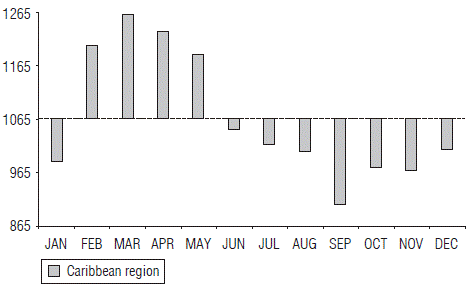Introduction
The eggplant (Solanum melongena L.) is native to India and was introduced to Colombia by the Spaniards around the 1930s. Nowadays it has high commercial acceptance in the Colombian Caribbean region to the point that it is widely utilized in the regional gastronomy and is prioritized in the productive bets with an export view mainly for the provinces of Cordoba and Sucre (Aramendiz et al., 2008; Tapia et al., 2015). According to official statistics, the Caribbean region of Colombia for the year 2018 obtained a production of around 4.298 t that represents 93% of the national production (Agronet, 2019). Likewise, the imports of eggplant by the United States, Canada, and the Caribbean islands account for approximately 95,000 t, representing a market value close to 105 million dollars/year (FAOSTAT, 2019).
The strategic location of the Colombian tropics whose environmental offer allows the production of eggplant throughout the year, plus the proximity to the main ports of the country, generate favorable conditions to obtain competitive and commercial export advantages. These benefits can be exploited by those producers who have or exceed technological aspects to satisfy specialized international and national markets in terms of quality, quantity, continuity, and innocuousness in production. In this sense, typification or characterization studies of agricultural production systems are of great interest because they allow identifying groups of producers within the heterogeneity of socioeconomic and productive conditions. This way, government entities, unions and decision-makers can direct public policies and investment as well as research and technology transfer programs that are tailored to the circumstances, limitations and possibilities of the groups of producers identified (Escobar and Berdegué, 1990; Correa et al., 2010; Santos et al., 2014).
The multivariate statistical analysis techniques constitute ideal tools for the characterization and classification of agricultural production systems (Arias and Gálvez, 2010; Correa et al., 2010; Carrillo et al., 2011; Cleves and Jarma, 2014). Among the existing multivariate methods, Gower's coefficient of similarity allows the simultaneous manipulation of quantitative and qualitative variables in a database. With its application, it is possible to find the similarity between individuals to whom a series of common characteristics have been measured. Once the similarity between elements is obtained, the coefficients can be transformed into distances. Subsequently, a grouping of individuals can be carried out in such a way that each group is composed of homogeneous units, and the groups among these will be very heterogeneous (Gower, 1971; Franco and Hidalgo, 2003; Chauza and Villa, 2011).
Despite the importance of the cultivation of eggplant, and especially the Caribbean region that contributes 74% of the national production, there is no history of studies defining the typology of farmers. These studies are necessary at the time of designing technologies in such a way that they respond to the needs of the producer, facilitating their adoption.
The typification of producers in a production system allows us to appreciate the technological level and some socio-cultural variables such as the age of the farmer, the experience in cultivation that is considered important to design models of rural extension and improve production and market conditions.
This research hypothesized that eggplant production in the Caribbean region is carried out with different technological levels, which must be defined to formulate technological recommendations that respond to the needs of different producer groups. In that order of ideas, the ignorance of the elements linked to the eggplant production in the Colombian Caribbean region is a limitation to improve the competitiveness and productivity of this crop in this region.
Accordingly, the aim of the research was to identify the production technologies, agronomic practices and socioeconomic characteristics of eggplant producers in the Colombian Caribbean region, to generate a baseline of the production system as an input to formulate projects on the research agenda of this area. Moreover, this will also be used to measure the impacts of future technologies according to estimations of the social balance of different institutions of the agricultural sector.
Materials and methods
The research was conducted in the second semester of 2018 in eggplant producing areas of the Colombian Caribbean region. For this, aspects related to the socio-economic, technological, and productive characteristics of eggplant producers were studied through the application of surveys with structured questions (Tab. 1). The sample size was established by a simple random sampling design without replacement, considering maximum variance according to Equation 1:
where:
N = population size
Z2 ∞/2 = value of the standard normal distribution for a confidence level of 90% (1.645)
p = value of the a priori proportion of max imum variance of a proportion variable (0.5)
ε = maximum allowable error of the 12% estimate (0.12)
n = sample size
For this study, the population size was expressed as the number of eggplant producers in the Caribbean region, which was determined by the quotient obtained from the most recent official report of the eggplant harvested area in the region (364 ha for the year 2017) with the eggplant modal planting area (≈ 0.622 ha). The Corporacion Colombiana de Investigacion (Agrosavia) -stimated the latter through research (Cadena et al., 2011a). Likewise, the values considered for Z2 ∞/2, p and s were 90% (1.645), 0.5 and 12% (0.12), respectively, obtaining a sample size of 46 producers.
One of the advantages of using Ward's method in this research is that it is the only hierarchical grouping method that bases its functionality on a regular sum of squares criterion, which allows obtaining defined groups and minimize the dispersion of each element in each group produced (Murtagh and Legendre, 2014). The measurement of distances through specialized software generates dendrograms that show the similarity/dissimilarity between defined groups.
The qualitative variables were: gender, educational level, state of access roads to the property, land tenure, years of experience as a producer, type of labor, age of family labor, access to credit, origin of income, technical assistance service, production destination, topography, and water availability for irrigation. The quantitative variables were the size of the productive unit, cultivated area, yields, total production, and quantities sold.
The socioeconomic and technological aspects of the production of eggplant (Solanum melongena L.) in the Colombian Caribbean region are presented in Table 1, which are the product of fieldwork seasons through surveys applied randomly to farmers in the regions. The socioeconomic information refers to the age of the producer, experience in cultivation, gender, services, and size of the productive unit. The technological information highlights crop management yields and cultural practices.
TABLE 1 Socioeconomic and technological aspects inquired to eggplant (Solanum melongena L.) farmers in a survey carried out in producing areas
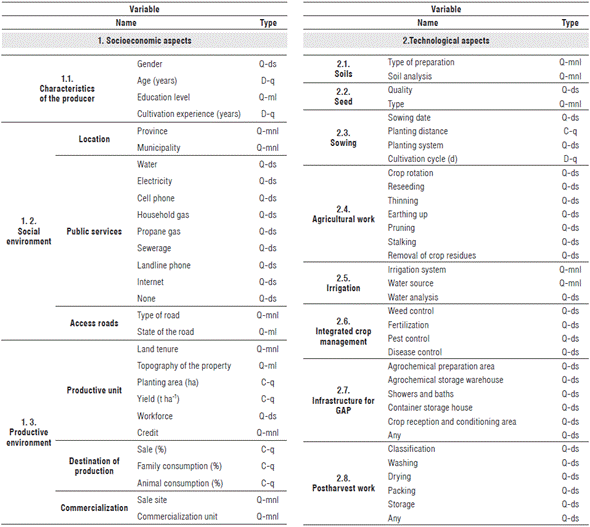
Q-ds qualitative double state; Q-mnl: qualitative multistate, non-logical; Q-ml: qualitative multistate, logical; C-q: continuous quantitative; D-q: discontinuous quantitative; GAP: good agricultural practices.
For the data analysis, the variables that did not show any variation were discarded. The grouping of producers was carried out through multivariate analysis using Gower's distance (Eq. 2) and Ward's hierarchical agglomerative clustering; method, and employing the statistical program InfoStat version 2017 (Di Rienzo et al., 2017).
where,
S ij
S ij : Gower's similarity coefficient
P 1: number of continuous quantitative variables
P 2:number of binary variables
P 3:number of qualitative variables (non-binary)
α: number of matches (1, 1) in the binary variables
d:number of matches (0, 0) in the binary variables
α: number of matches in the qualitative (non-binary) variables
Rh: the range (or path) of the h th quantitative variable
Results
The multivariate analysis of mixed data allowed the formation of five conglomerates (GI, GII, GIII, GIV and GV) of farmers, which evidences the existence of divergence in eggplant producers of the Caribbean region (Fig. 1). Groups GII and GV are comprised of farmers from the province of Cordoba; however, GII is integrated by producers from a single municipality (La Apartada, Cordoba). Furthermore, groups GIII and GIV are the most diverse in terms of the place of origin of the farmer, which includes six and seven municipalities, respectively (Tab. 2), showing signs of heterogeneous production processes at the eggplant production area level in the Caribbean region of Colombia.
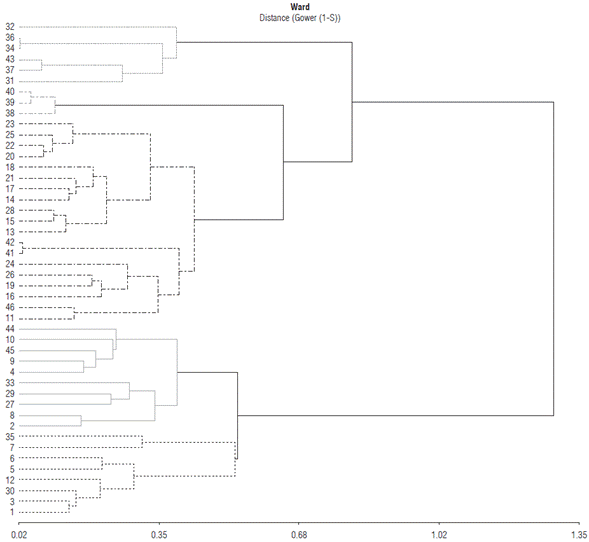
FIGURE 1 The conglomerates of eggplant farmers established using multivariate analyses such as Gower's distance and Ward's hierarchical agglomerative clustering method.
TABLE 2 Socioeconomic aspects of eggplant (Solanum melongena L.) farmer groups in production areas of the Colombian Caribbean.
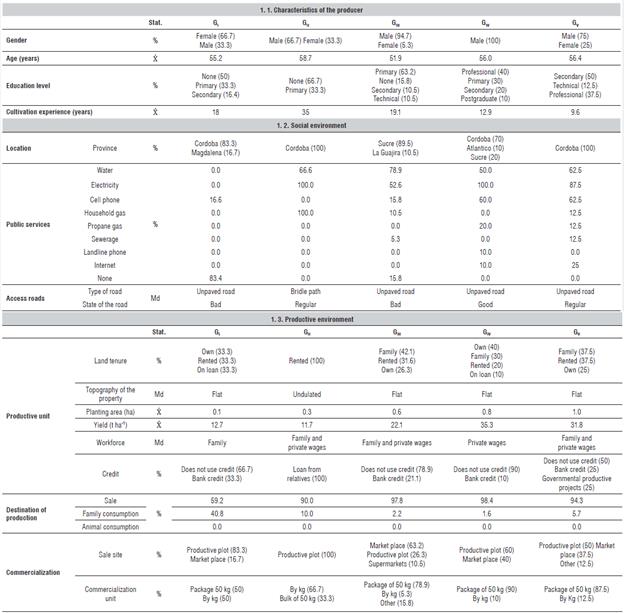
Stat.: statistics; Ẋ: average; Md: mode; GI, GII, GIII, GIV, and GV: Groups of farmers established using multivariate analyses (Gower’s distance and Ward’s hierarchical agglomerative clustering method).
The GI group represents 13% of the sample, and its members are characterized by being located in the rural area of the municipalities of La Apartada and Monteria in the province of Cordoba, and Sitionuevo of the province of Magdalena. In this group, about 67% of its members are women with an average age of 55 years, with a low schooling level (no study = 50%, primary = 33.3%), and on average, 18 years of farming experience. The productive units have a flat topography, roads in poor condition, almost no access to public services such as electricity, drinking water, household gas, landline phone, and Internet, and the agricultural land shows varied forms of tenure (own 33.3%, rented 33.3%, on loan 33.3%). The planting areas are on average 1,000 m2 with average yields of 12.7 t ha-1; production costs are ma inly undertaken using their own resources (66.7%) and usi ng family labor. The production is destined for sale (59.2%) and family consumption (40.8%) in a very similar proportion; likewise, the harvested fruits are sold mainly in the production plot (83.3%), either in 50 kg packages or as retail by kilograms (Tab. 2).
In terms of local production technology, farmers that carry out soil preparation manually and do not perform soil analysis characterize group I. They usually use seeds from regional cultivars obtained from their own crops; they plant once per year in April and in monoculture using planting densities of 1.1 m x 1.2 m between plants and rows, respectively, corresponding to 7,572 plants ha-1. These farmers fertilize with chemical sources and achieve productive cycles of 298 d on average (« 10 months); a moderate number of its members carry out agricultural work intensively, highlighting reseeding, earthing up, stalking, and removal of crop residues. Likewise, these farmers have not implemented commercial irrigation systems, supplying the water needs of the plants with artisanal manual irrigation and obtaining water from nearby rivers (Magdalena, Sinu, and San Jorge). The infrastructure for the development of good agricultural practices (GAP) is null. However, a significant number of its members carry out the most critical postharvest tasks such as classification, washing, drying, packing, and storage (Tab. 3).
TABLE 3 Technological aspects of eggplant (Solanum melongena L.) farmer groups in producing areas of the Colombian Caribbean region.
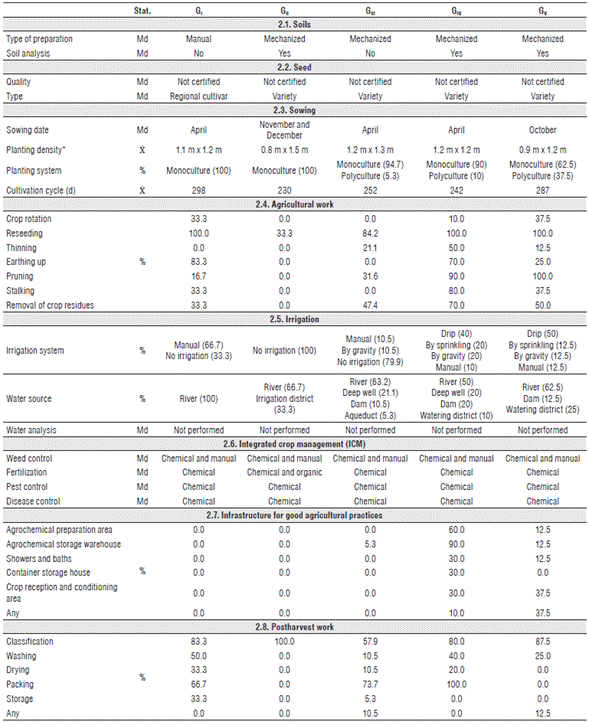
Stat.: statistics; Ẋ: average; Md: mode; GI GII, GIII, GIV and GV: groups of farmers established by multivariate analyses (Gower's distance and Ward's hierarchical agglomerative clustering method). "Distance between plants and rows, respectively.
The GII group corresponds to producers settled in the rural area of the municipality of La Apartada (Cordoba). Most of producers are men (66.7%) with an average age of 59 years, a low schooling level (no study = 66.7%, primary = 33.3%) and extensive experience in the cultivation of eggplant (35 years). The productive units have mainly undulated topography, the access road is in good condition, there is good coverage of residential public services (66.6% of water, 100% of electricity and 100% of household gas) and the agricultural land is mostly rented. The average planting area is 3,000 m2 with average yields of 11.7 t ha-1; production costs are financed by loans from family members and by combining family labor with private wages. The production is destined mainly for sale (90%) and is commercialized by kilograms (66.7%) in the production plot of the farmer (Tab. 2).
The technological aspects involve land preparation with agricultural equipment and soil analysis, plantings from November to December in monoculture (87%), with planting densities of 0.8 m x 1.5 m between plants and rows, respectively (8,325 plants ha-1), no irrigation is applied, and they use the San Jorge River as a source of water. Further, they use chemical and organic fertilization sources and reach productive cycles of 230 d 7.7 months), with little implementation of traditional agricultural work. The infrastructure for the development of GAP is null, and the only postharvest work that is carried out is the classification of fruits (Tab. 3).
The GIII group covers the largest number of producers, i.e., 41.3% of the sample. Its members are mainly from the province of Sucre (89.5%); most of them are men (94.7%) with an average age of 52 years, a low level of education, and around 19 years of experience in the cultivation of eggplant. The productive units have flat topography, there is poor access to roads, with a coverage of 78.9% and 52.6% of water and electricity services, respectively, and various land tenure types (42.1% belongs to the family, 31.6% is rented, and farmers own the land 26.3%). The average crop area is 6,000 m2 with average yields around 22 t ha-1; the production costs are assumed mainly with their own resources and combining family labor with private wages. The production is mostly destined for sale and is purchased at various points (municipal market, supermarkets, and production plots) in units, by kilograms, or packages of 50 kg according to the nature of the market (Tab. 2).
Regarding technological aspects, farmers use mechanized soil preparation, they do not perform soil analysis, and traditional planting is carried out in April, mainly in monoculture (94.7%) using planting schemes of 1.2 m x 1.3 m to obtain populations of 6,407 plants ha-1 in average production cycles of 252 d (8.4 months). The agricultural tasks that are mostly carried out are replanting (84.2%) and removal of crop residues (47.4%). Likewise, the implementation of irrigation in eggplant (21%) is low, but with various water sources for available irrigation (river, deep well, damn and aqueduct). Only 5.3% of its members have an agrochemical storage warehouse and, postharvest work is carried out at a low proportion (Tab. 3).
Group GIV comprises 21.7% of the sample, and its members are scattered in the provinces of Cordoba, Atlántico, and Sucre. All farmers are men with an average age of 56 years and a varied level of schooling. It could be observed that 50% have a professional and postgraduate school degree level with average experience in the crop of approximately 13 years. The productive units have flat topography, the access roads are in good condition, and there is good coverage of public services such as drinking water (50%) and electricity (100%) with agricultural properties mainly owned by the farmer or by the family. The cultivation areas are on average 8,000 m2 with average yields of 35 t ha-1; the production costs are assumed mainly with their own resources, and the labor used is hired (private wages). The production is destined mainly for sale (98.4%) and commercialized predominantly in packages of 50 kg in the production plot to intermediaries of the region and sold in municipal market places (Tab. 2).
Technological aspects involve mechanized soil preparation with soil analysis, one planting per year in April in monoculture (90%) and using planting densities of1.2 m x 1.2 m between plants and rows, respectively 6.944 plants/ha). Likewise, they perform the everyday tasks demanded by the crop (crop rotation, reseeding, thinning, earthing up, pruning, stalking, and removal of crop residues) in high proportion, and at least 80% of the farmers implement irrigation systems to meet the crop's water requirements. In this group, at least 30% of the farmers have GAP infrastructure, with facilities such as an agrochemical storage warehouse (90%), an area for the preparation of agricultural supplies (60%), and carry out postharvest tasks such as classification, washing, drying and packing (Tab. 3).
The GV group represents 17.4% of the sample, and its members are located in the province of Cordoba and distributed among the municipalities of Cerete, La Apartada, Monteria, and San Pelayo. Seventy-five percent (75%) of the producers are men with an average age of 56 years, they have a variable level of education (50% secondary, 12.5% technical and 37.5% professional), and around 10 years of experience in the cultivation of eggplant. The productive units have flat topography, the access to roads is in a regular state, there is an acceptable coverage of public services (62.5% water, 87.5% electricity, and 25% Internet), and land tenure is diverse (family farms 37.5%, rented 37.5%, and own 25%). The average crop area is 1.0 ha with average yields of around 32 t ha-1; production costs are mainly undertaken using their own resources (50%). However, other funding sources stand out, such as bank loans and government resources through productive projects. The workforce is familiar and complemented with the hiring of family wages, with production destined mainly for sale (94.3%), and commercialized in the production plot and municipal market places in packages of 50 kg and per kilogram (Tab. 2).
The technological aspects of this group involve mechanized soil preparation and soil analysis, one planting per year in October in monocultures (62.5%) and polycultures (37.5%), and using planting distances of 0.9 m x 1.2 m between plants and rows, respectively 9.259 plants ha-1). Likewise, they perform the everyday tasks demanded by the crop (crop rotation, reseeding, thinning, earthing up, pruning, stalking, and removal of crop residues) in a high proportion; at least 75% implement irrigation systems to meet the water requirements of the crops. In this group, at least 12.5% of the farmers have GAP infrastructure, with facilities such as a harvest reception and conditioning area, an agrochemical storage warehouse (12.5%), an area for the preparation of agricultural supplies (12.5%), showers and baths (12.5%), and postharvest work is carried out, including classification and washing (Tab. 3).
The groups described above share common characteristics such as having unpaved roads, the use of seed selected from their own crops (not certified), they do not perform water analysis for irrigation, they perform weed control by combining herbicides with manual weeding, and use only chemical pesticides for the control of pests and diseases (Tabs. 2 and 3).
Discussion
The results reveal, in general, a low (GI, GII, and GIII) to medium (GIV and GV) technological level in eggplant production in the Colombian Caribbean region. In this regard, some studies have found that aspects, such as the technological level and the adoption of technologies, have a direct relationship with the schooling level of farmers (Damián and Ramírez, 2008; Aguilar et al., 2013; Ayala et al., 2013; Vargas et al., 2015; Garrido et al., 2017). This is consistent with the results obtained in this study, in which the groups with the highest level of education (GIV and GV) showed the highest yields (GIV = 35 t ha-1, GV = 32 t ha-1). Furthermore, this is explained mostly because these groups execute agricultural work implementing irrigation systems, crop nutrition based on soil analysis, and have GAP infrastructure (Tab. 3).
The average age of the eggplant producer groups was similar among the groups, with a range between 52 and 59 years. In related research, Correa et al. (2018) found that squash producers in the Caribbean region of Colombia showed a similar average age range (between 42 and 53 years). These results represent the socioeconomic reality of the rural areas, where the generational change of farmers is uncertain due to the precarious conditions of competitiveness of small farmers. This happens mainly because there is a lack of fair marketing scenarios that directly influences the profitability of agricultural products (Villalobos, 1984; Correa et al., 2010; Jaramillo and Riveros, 2013).
Eggplant producers with a lower technological level (GI, GII, and GIII) register cultivation areas between 1,000 m2 and 6,000 m2. These results are similar to those obtained by Agrosavia in 2011, in which the areas destined to the crop ranged between 1,000 m2 and 5,000 m2 (Cadena et al., 2011a). This shows a null growth in the productive units for this segment of producers. However, the official figures on eggplant planting areas at the regional level show a growth close to 500% between 2011 and 2017 (Agronet, 2018). This growth can be explained by the incursion of producers included in groups GIV and GV with more extensive productive units (0.8-1.0 ha) and higher capacity for economic and technological investment.
Despite the crucial advances in the generation of knowledge at the local and regional level for the cultivation of eggplant in areas, such as the production of planting material and substrates (Aramendiz et al., 2013), water requirements (Sánchez et al., 2004), weed management (Aramendiz et al., 2010; Hernández et al., 2015), nutrition (Cantero et al., 2015), phytosanitary management (Tamayo and Jaramillo, 2006, 2013; Gómez et al., 2012), planting densities (Pérez et al., 2006), agronomic crop management (Aramendiz et al., 2008; Tapia et al., 2015), postharvest (Escobar et al., 2011) and new eggplant cultivars (Aramendiz et al, 2011; Cadena et al., 2011a, 2011b), the adoption of these technologies may be limited by the high level of illiteracy among producers, mainly in the GI, GII and GIII groups, showing a level of illiteracy of around 50%, 67% and 16%, respectively (Tab. 2). In this regard, Salcedo and Guzman (2014) point out that the level of education in Latin America is low with a high level of illiteracy, with Colombia registering an average of 5.6 years of schooling in transitional family agricultural producers (i.e., that have only completed their primary education).
Authors such as Barrientos and Torrico (2014) point out that the socio-economic perspectives of family farming (FF) in countries such as Colombia move mainly to the rhythm of the markets. Furthermore, their transformation from a subsistence condition to a commercial situation and vice versa depends mainly on the availability of sufficient resources for production, mainly regarding land, labor, and financial capital. In this sense, according to the FF typologies, eggplant production in the Colombian Caribbean region can be framed as a transitional FF, whose typology in the country represents around 12% of FF (Salcedo and Guzman, 2014; Sabourin et al., 2015).
The study reveals that the predominant sowing date is in April; this is because the rainy season in the Colombian Caribbean region begins in this period, so the vast majority of farmers establish their crops at this time of the year. This, however, leads to the formation of the phenomenon known as "supply seasonality," which corresponds to the oversupply of production, mainly from June to November (Tab. 3, Supplementary Material 1). In this regard, the dynamics of prices in the primary market places in the region show low seasonality of prices between June and January, with a recovery period during February and May (Fig. 2). These results have great significance by associating the behavior of prices with the productive cycles of the crop, which moves between 7.7 and 10 months (Tab. 3), of which, the first 2.5 months correspond to the vegetative period (unproductive stage) and the remaining period (5 to 8 months) to the reproductive (flowering) and productive (harvest) stages. There is a progressive growth in production during the first six months that descends significantly after the seventh month as a result of crop senescence. This, in turn, explains the recovery of prices due to the substantial decrease in supply. Hence, the preference for a segment of producers that sow between October and December in search of favorable marketing prices is revealed.
Conclusions
Eggplant cultivation in the Caribbean Region of Colombia has shown growth in area and production, explained by the increase in consumption and the incorporation of technologies such as irrigation. In addition, this kind of technologies increases yields and decreases seasonality which contributes to its rates of implementation.
Planting dates are associated with the appearance of rains that usually occur in the third week of April, which is a rule for those farmers who do not have nearby water sources and purchasing power to gain access to pressurized irrigation systems, as is the case of farmers located in the flat areas. The other type of farmers, such as those in the Sinu Valley and other productive areas with permanent water sources, take advantage of this asset by growing at different times of the year, thus, breaking the seasonality of production.
The socioeconomic conditions of eggplant producers are heterogeneous, and their technification ranges from low to medium levels. Likewise, as standard features among the groups identified, the crop is cultivated by farmers with average ages between 52 and 59 years who are considered elderly (≥60 years), and with little participation of young people. In the medium term, this can have a significant impact on the reduction of regional production. Therefore, it is imperative to implement a regional rural extension program in the short term, aimed at the adoption of technologies that have been generated, to improve the productive conditions of farmers as well as the sustainability and attractiveness of this economic activity for current and future generations of producers in this region of the country.
The crop is highly dependent on chemical synthesis inputs required for phytosanitary management and crop nutrition, a situation that may be generating a significant environmental impact on the health of producers and consumers, in addition to raising production costs. Therefore, the study reveals that the implementation of research lines aimed at developing integrated pest, disease and nutrition management is a priority to improve the safety and sustainability of the eggplant production systems in the Caribbean region of Colombia.
















